Fowl Play: Kumoon
Kumoon by Mikko “Mayoneez” Oksalahti is a bizarre little game. It plays a bit like a physics demo with some rough goals slapped on top. Despite that, though, it’s actually a lot of fun. The official site describes the game as:
Kumoon is a hybrid of a third person shooter and a puzzle game. Player controls a chick that tries to knock down boxes in various rooms by shooting them with a revolver, shotgun or a bazooka.
Wait, What?
It’s a bizarre combination of play styles. The goal of the game is to turn all of the red boxes to white without incurring too many negative points. You turn the color of a box by jarring it, either with one of your weapons to by pushing something into it. Using your weapon, past the first free shot, will cost you points. Touching a red box will cost you points. You get points back by turning boxes white, which can be multiplied by bouncing a shot off something en route to its target.
Puzzle Elements
Despite its puzzle influences, Kumoon doesn’t resemble a logic game. Most of the stages play in a very free-form fashion. Instead of a single “correct” solution, you can change the blocks’ colors in any order you see fit. There are some rules you should apply, though. It’s best to start with higher blocks and leave low-lying blocks for last. It’s easy to push white blocks against red blocks on the ground.
The later levels introduce platforms, pedestals, and other means of isolating red blocks. Sometimes you really do need to use a weapon, which means you need to save up your points. I played through the game without doing a lot of combos, which made some weapon-heavy levels much harder than they could have been had I learned how to properly combo.
More Puzzle, Please
The last stage of the game is the only one that plays like a puzzle. It actually forces you to pass by scoring combos; you must figure out exactly where to bank your shots. It’s very billiards-esque mechanic. It was fun to figure out exactly where to shoot in order to pass the level (stand next to the pedestal and aim at the 7th line up on the wall). It makes me wish more of the game leaned into this style of play, aided additional features to easily tell where the last shots went: tracers, paint dabs on the wall where they bounced, predictive lines, etc.
Then again, the freedom in the game as it stands has a certain addictive quality to it. You could play through the game as a block-pusher, or figure out how to rack up points with combos, or meticulously set up physics domino sequences to get all of the red blocks. The game definitely supports a number of different play styles.
Physics Engine
Kumoon uses a custom physics engine written by the author, called MOPE. It’s an impressive effort for a one-man job. The physics perform very well, although it does seem like the engine has no concept of mass. The large objects tend to float and feel as if they weigh the same as the smaller objects.
Not Just for the Birds
Kumoon is totally free. It’s a great example of how physics games can take simple mechanics and turn them into a surprising amount of entertainment. The room setup files are in a documented format, too, so if you burn all 39 levels in one sitting there’s always the option to make some more. If you do, shoot me an email–I need more levels to play!
Download Kumoon game here (6.18 MB) or head over to the official website for more information and a MacOS build.
Related Posts:
Toybox: Why Buy New When Digital Will Do?
Toybox by Souptoys is a neat product. It isn’t exactly a game, in that you aren’t given any concrete goals. There’s nothing to accomplish; it’s a toy. Souptoys describes their product as:
Souptoys are the newest way to have fun on your computer. Sitting right alongside your other applications, Souptoys turn your desktop into a playroom. They are fun and simple to play with and have unlimited possibilities. Build great castles, set up fantastic contraptions, decorate your desktop or just fling your toys around. It’s your choice – They’re your toys!
Desktop Toy
Basically, Toybox is a collection of 60 different physics contraptions: Levers, balls, balloons, catapult, and so on. The application is a desktop toy in the sense that it doesn’t go full screen or have its own primary window. Instead, the toys have their own transparency and fit into the normal Windows drawing order.
Playsets
Toybox ships with 39 different pre-configured setups, called playsets. Some are fairly static, like castles and flower beds. Others are designed with interaction in mind. The video is captured from the “Target Practice”. It’s obviously set up so you can lob baseballs at the different toys set up across from the catapult. Of course, you could always pick up the blocks directly and smash things apart yourself.
You can save your own playset, which records the position of all of the objects. I didn’t see any way to manually edit the positions of things, though. For instance, you couldn’t place 10 balls hanging in the air and save that starting position as a playset (they would all fall to the ground before you could click the save button).
There are additional playsets available on their website, too, uploaded by other users. The process is a little cumbersome, unfortunately. Uploading and downloading new playsets should be handled in-application, particularly if they’re hoping to engage the casual user.
Lasting Fun?
Toybox is available with an Armadillo-controlled 60-minute trial period. Despite its technical uniqueness and plethora of options, I can’t really see myself playing with Toybox past those 60 minutes. I’m probably not representative of their market, but I crave just a little bit more–some kind of multiplayer, maybe, which would be worth the additional development. Or perhaps the addition of goal-direct minigames would keep me playing. As it stands, I fiddle around with things for a few minutes before I inevitably end up bored. I’m willing to admit that I simply lack the imagination necessary to play with toys.
Business Model
If you’re looking for inspiration for alternative business models, Toybox is a good example of something that completely breaks the mold of most downloadable games. If they’re able to improve their community features I think they’ll be able to slowly build a user base. And then, of course, sell expansion pack after expansion pack of new toys. I’m very curious to know if they’ve thought out their long-term business plan at all.
Try It Out!
Toybox is a great way to unwind, particularly if your real desk is far too cluttered to play with toys (or perhaps far too cluttered with toys). It’s a fun time waster, and clicking the X is certainly a lot faster than picking up after real toys.
Head over to Souptoys’ webpage to download the 60-minute Toybox demo (12.5 MB).
Related Posts:
Plasma Pong: Fluid Dynamics in a Pong Game
Plasma Pong is a mesmerizing freeware title by Steve Taylor, a student at George Mason University. It combines a cutting-edge realtime fluid dynamics simulation with the game structure of pong. Steve’s describes the game as follows:
Players have several new abilities that add fun twists to the classic game. In the game you can inject plasma fluid into the environment, create a vacuum from your paddle, and blast shockwaves into the playing area. All these abilities have fluid-based kinetic effects on the ball, making Plasma Pong a fast-paced and exciting game.
Gameplay
There isn’t a whole lot to say about the gameplay in Plasma Pong, really. The game structure mirrors that of the original Pong: You score if the ball makes it past your opponent’s paddle and vice versa.
The right-mouse button creates a vacuum and sucks the ball towards you. This is a great way to safely catch the ball, as the fluid dynamics tend to create sudden unpredictable movements as the ball gets caught in eddies and currents.
Left-mouse button fires plasma which shoots into the playfield. It can be used to push the ball for some extra speed, but also modify the currents. If you can succesfully create an eddy near the opponent’s side you can usually score when the ball makes sudden last-second movements.
Questionable Intentions
Despite its advanced physics simulation, I found myself playing Plasma Pong as I would nearly any pong game. It’s hard to use the fluid dynamics in a deliberate way to your advantage. This is kind of a shame, because if the game were more easily able to manifest my intentions as a player I think it would be much more addictive. As it stands now, though, the player experience flattens out to mere repetition after a few minutes.
I would have loved to see obstacles like walls, wave machines, powerups, or other changes to the mundane back-and-forth mechanic. To be fair, the game is a pong clone, but so much more could be done with the simulation engine. Maybe a fluid dynamics-based shooter?
Visuals
The game is a visual treat, at least. It’s almost as fun to play the game itself as it is to simply watch the physics simulation. In fact, you can press F1 to toggle over to an interactive fluid simulation that does away with the pong ball and paddles completely. I played with this almost as long as I played with the game itself.
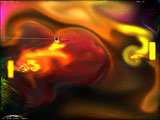
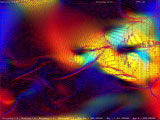
(Plasma Pong Game Screenshots)
It’s Free
Plasma Pong is free; why aren’t you playing it already? It’s a neat example of using real-time fluid dynamics to replace the physics of an existing game. The result is half physics game, half graphics demo. It’s an interesting study–what would you change as a designer to add more depth to the experience?
Download Plasma Pong game (6.56 MB), or head over to the official Plasma Pong site.
Related Posts:
« Previous Page — Next Page »


 (Rate this game! 167 votes, average: 3.89 out of 5)
(Rate this game! 167 votes, average: 3.89 out of 5)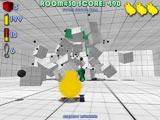
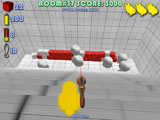
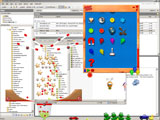
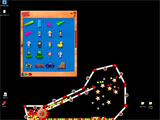
 My name is Matthew Wegner, and this site is dedicated to physics games.
My name is Matthew Wegner, and this site is dedicated to physics games.